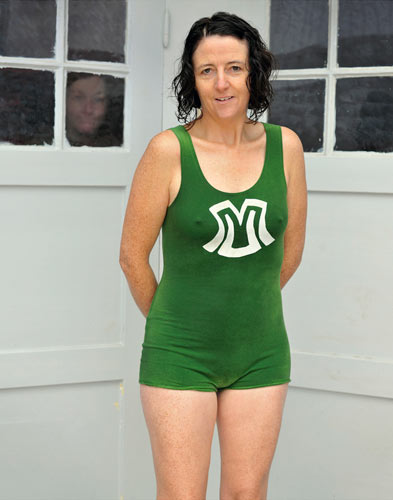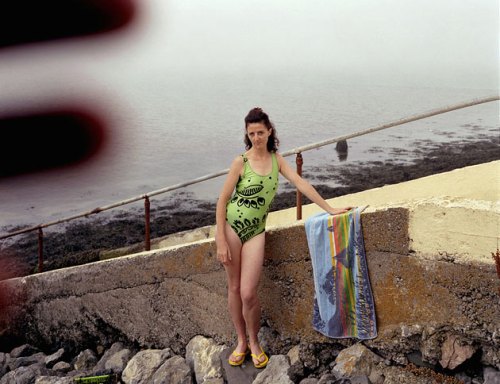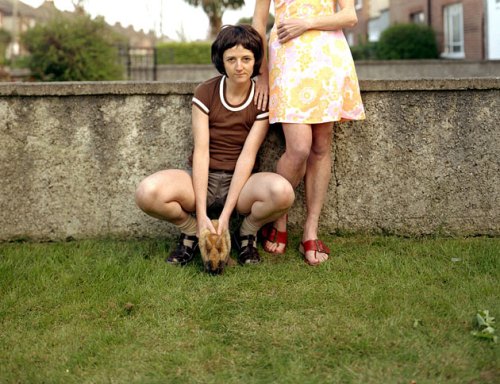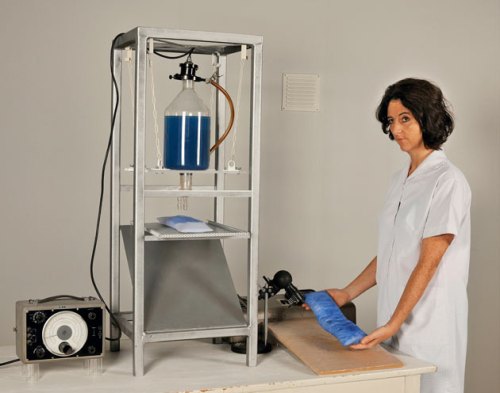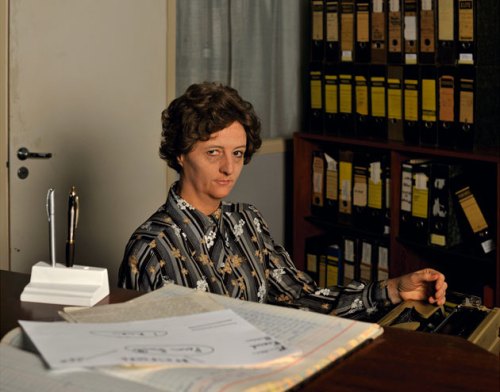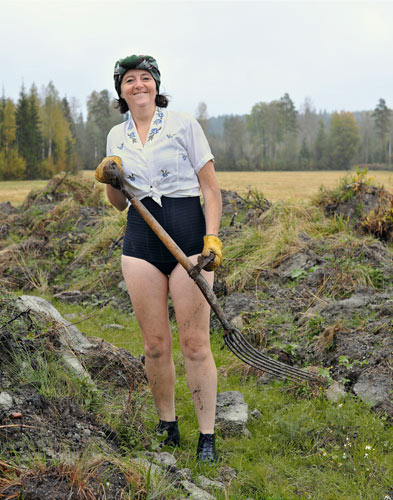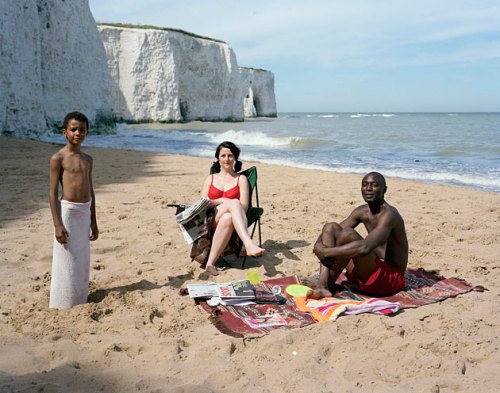Trish Morrissey
by Sharon Boothroyd
Fig. 0395GAS (TM) Aune Heimolainen, one of the best swimmer
girls in Mänttä Sporting Club. 1943 / 2015. Mänttä, Finland.
From the series Ten People in a Suitcase by Trish Morrissey.
Trish Morrissey is an Irish artist with international acclaim. Her work situates itself between self-portraiture and performance. She is known for considering themes of identity with an arresting humour, and yet it is a humour underpinned with poignancy and pathos. So much so that the effect is sometimes one where the viewer doesn’t know whether to laugh or cry. It’s as if she tells us a joke, but the joke is a bit too close to home, so it makes us wince as we recognise something of ourselves in the punchline.
Trish’s work has been shown in prestigious museums worldwide, recently at the National Portrait Gallery and Turner Contemporary, Margate and is held in collections such as the V&A, The National Media Museum, and The Museum of Fine Arts, Houston.
Sharon Boothroyd: Tell us about your first forays into photography. What led you to it and what keeps you there?
Trish Morrissey: As a teenager growing up in Dublin I had no idea what photography could be beyond the celebration picture, the wedding, the newspaper, the magazine. A lucky set of circumstances meant that I got a job straight out of school in the photography department of the Irish Independent, one of the three national daily newspapers in Ireland. I was working in the dark room, preparing chemicals and processing black and white film and printing. I was also filing the negatives afterwards. So I was discovering the alchemy of light and chemicals in a very hands on way. I borrowed a camera from the department and started doing street photography. It was a bit like a drug. I carried the camera with me everywhere. The newspaper was situated on the north side of the city centre. Across the bridge on the quays I discovered The Gallery of Photography. A mouldy creaky basement gallery and bookshop which specialised in photography was where I discovered the work of Diane Arbus. I remember the first time I opened one of her books and saw ‘Young man in rollers’. This was the late 1980’s, I had been raised a fairly strict catholic, educated by nuns. Growing up in this period in Ireland, was more like the 1950’s in the UK. And while Dublin was a European city, it was extremely monocultural. A mixed marriage was between a catholic and a protestant. The only people of colour to be seen were the odd student from the Royal College of Surgeons. Homosexuality had yet to be legalised. The work of Diane Arbus opened my eyes. Reading what Diane said about her approach to photography really chimed with me. Her idea that photography lies somewhere between the intention (of the photographer) and affect (of the picture) was key to my first forays in to photography.
Though photography is central to my work, I have made 2 moving image and one sound piece. Though of course even these are a bit of a reaction to the limits of photography. The photographs I have made in recent years are photographs about the language of photography, and more recently they are heavily performance related. It is hard to say what ‘keeps me in photography’. Mostly the impulse to make work is a feeling of something that has to escape, like air out of a balloon.
August 8th, 1982 from the series Seven Years by Trish Morrissey
Seven years is about you revisiting your family album. How personal is this work for you?
What does the family album mean to you now?
The personal element in Seven Years is not the family album aspect, but rather working with my sister who was extremely generous in her time, and in fact she also donated some money towards the project. The pictures themselves are not related to my own personal pictures, but rather they are about generic family album photographs. They are moments when we all take pictures, i.e, the celebration, the new baby, the pet, the day out, the beach, the picnic. But they all have a dark twist. Humour is probably the first emotion encountered by the viewer, but I think that soon fades to a slow burning psychological affect. Secrets. The project is all about secrets.
July 22nd, 1972 from the series Seven Years by Trish Morrissey
Although the images are not direct copies they are nevertheless convincing. This meticulous approach returns in your work. What did you learn through this process?
The attention to detail is essential to my work as I am asking viewers to suspend disbelief and this only happens when all the elements come together. In early attempts, I had made mistakes in costume or pose and the illusion simply fell apart. Leaving behind just comedy. Imagining a back story and really inhabiting the characters takes time, and often, many attempts.
You also make video pieces. What does the moving image provide you that the still doesn’t and vice versa. What satisfaction and cross-overs do you find from working in two mediums?
I made my first moving image piece, ‘Eighteen and Forty-five’ as an extension of photography, or rather as a push against the boundaries of the photograph. I had tried to photograph my mother’s wedding dress (that I had also worn for my school leavers party in 1988), in many different ways. But they all looked clunky and silly, nostalgic and foolish. The idea of the young body and the aged body in the same dress was really hard to do photographically. It needed other elements. When you have a film, you also have the potential for movement and sound. These new ‘spaces’ really appealed to me. But I see my moving image pieces as extensions of photography, rather than narrative film. They are so far, single point of view and often a single take. Like a photograph.
‘Eighteen and Forty-five’ opened up the possibility of moving image for me. Since then, ideas tend to come very clearly to me as either a photograph or a film.
Fig. 8097GAS (TM) An apparatus for testing the absorption ability
of a nappy. 1969 / 2015. Mänttä, Finland.
From the series Ten People in a Suitcase by Trish Morrissey.
In 10 people in a suitcase you were invited to respond to an archive which included objects as well as photographs. This must have been daunting! How did you decide which idea to pursue? Often artists have many ideas but struggle to hone in on one to completion. What would you advise young artists in this regard?
I was invited by Gosta Serlachius Fine Art Foundation to Mantta, Finland as artist in residence along with 8 other artists. We were asked to make work in the town itself, to find a way of getting to the essence of the place. As an artist, I find it impossible to turn up somewhere and shoot on the hoof. Or I might do that as part of research, but the final outcome needs much consideration and reflection. But the results of the residency were to form a group exhibition in the contemporary art space of the foundation the following year. I did not see how I could make something meaningful in such a time frame. While going through their website, I saw that they had an archive of over 30,000 pictures. The photographs were mostly of the ordinary folk of the town doing mundane things. I was allowed access and it was from there that the idea to use existing photographs of the residents of the town as templates to make new work from. The Foundation also has an enormous archive of objects and product samples from the Serla paper mill. The town had grown up around the mill in the mid 19th century. I used some of the objects as props in my photographs.
Fig. 00029KEL (TM) KMV-news office. 1972 / 2015. Mänttä, Finland.
From the series Ten People in a Suitcase by Trish Morrissey.
The question about how to identify an idea that has potential from the many ideas an artist might have is probably a personal one. For me it usually involves a lot of research around the subject and some experimenting. I work very slowly. The experimental period might not be making photographs, but trying to identify a character and how I might inhabit it. It might be finding props or costumes. If I don’t feel a connection, or if it feels clunky, it usually means that I am going in the wrong direction. A period of distance from the idea and the results of the experiments is usually helpful. Then you can look again with fresh eyes. Asking for opinions of others is key at this stage. But ultimately, you have to be brutally honest with your self. Sometimes after a lot of work and time, I realise that it is not going anywhere and move on. But even if this happens, it is all fuel to the fire, nothing is wasted as it most likely will lead to something better.
Fig. 04287KEL (TM) G. A. Serlachius Oy’s workers at Loukkusuo
peat bog. One Woman. 1943 / 2015. Mänttä, Finland.
From the series Ten People in a Suitcase by Trish Morrissey.
Can you talk about how you handle the editing process? How do you know when a project is finished?
Each project has its own flow, parameters, and formula, so it is really difficult to answer that question succinctly. I am a ruthless editor. The final 12 photographs I selected for the series ‘Front’ is about half of the pictures I made. With that series, I did not want it to become a typology. There is an entirely different series to be had from the out takes which could have been one where it is photographs of families of four. I wanted the pictures to be of individuals, rather than types. Having trusted advisors is essential to the process, but sometimes, even the opinion of the random man on the street can give rare insight. It is a good idea for young artists to form critique groups. It is something that I completely loved while at university and it often stops for students once they leave. Keeping that momentum going by meeting up, say once a month, can be really beneficial. Also, don’t be afraid of criticism, or being asked questions you can’t answer about your work. It will encourage you to look deeper into your rationale and can only improve the work.
Hayley Coles, June 17th, 2006 from the series Front by Trish Morrissey.
Looking back over your career in many ways you have been very successful. How do you define success?
Ha! Success! That’s a thorny old question. I worked commercially before I did my MA at LCC back in 2002. I earned quite a lot of money, for a few years, but I was miserable. I did not feel very successful because it all felt meaningless, shallow and wrong. So now, I make work that I really believe in, that I hope is meaningful, though I am poor as a church mouse.
